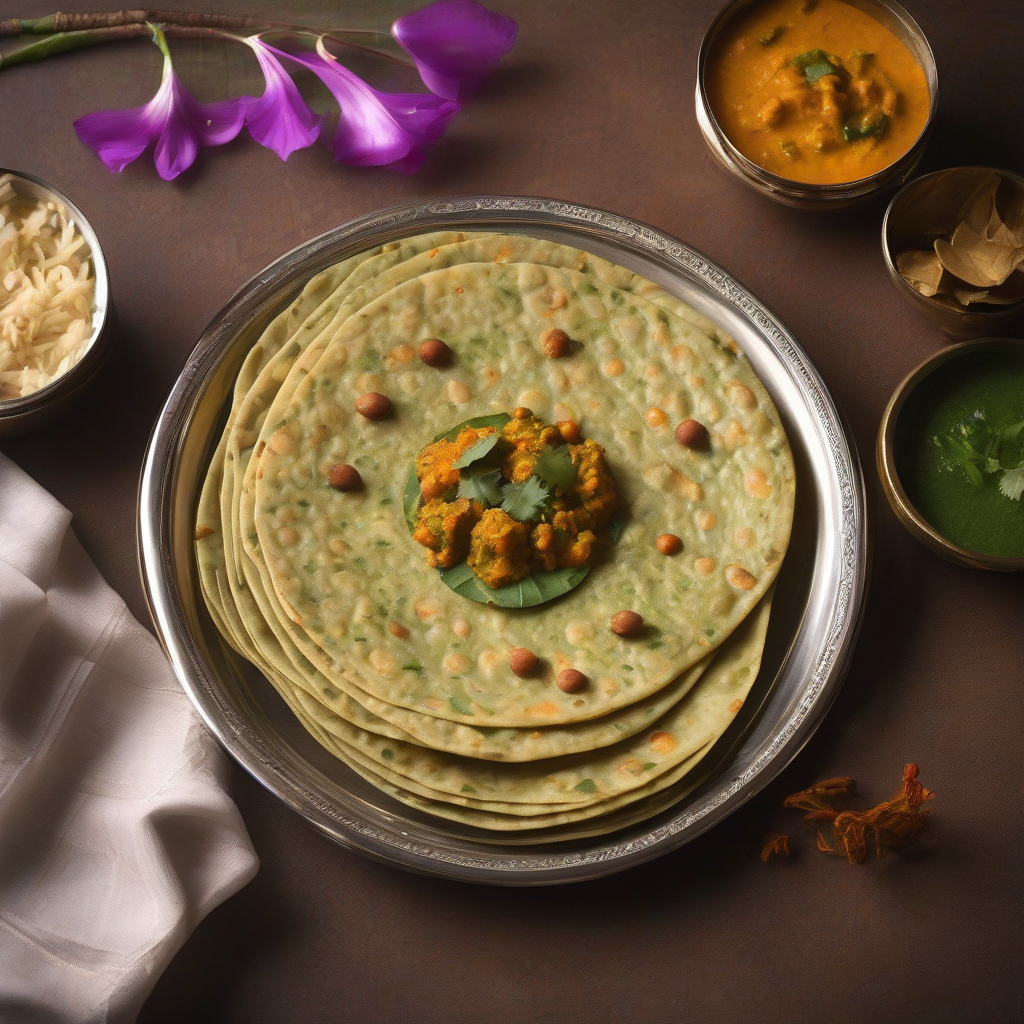Pithla Bhakri: A Taste of Home, a Hug on a Plate!
Namaste, Mitron! Kem cho? Kai Zhala? (Hello friends! How are you? What’s up?)
Chef Curry Do’pyaza here, back with another recipe that’s close to my heart – Pithla Bhakri! This isn’t just food, my friends; it’s a warm hug from Maharashtra, a taste of simpler times, and a dish that screams “home.”
Pithla Bhakri is a rustic, flavorful combination that is very popular in the rural parts of Maharashtra, especially during the cooler months. It is also a staple during festivals like Makar Sankranti and Mahashivratri, when families come together to celebrate and enjoy hearty, wholesome meals. This dish is simple, satisfying, and deeply rooted in the agricultural traditions of the region.
A Little History Lesson (Don’t worry, it’s tasty!)
Pithla Bhakri has humble origins. It’s a dish born out of necessity, created by farmers and laborers using readily available ingredients. Pithla, a thick gravy made from besan (gram flour), provided a protein-rich meal, while Bhakri, a flatbread made from jowar (sorghum) or bajra (pearl millet) flour, offered the necessary carbohydrates for a long day of work. It’s a testament to the resourcefulness and culinary wisdom of our ancestors!
Let’s Get Cooking!
Preparation Time: 15 minutes
Cooking Time: 30 minutes
Ingredients:
- For the Pithla:
- 1 cup Besan (Gram Flour)
- 2 cups Paani (Water)
- 1 medium Pyaaz (Onion), finely chopped
- 1 inch Adrak (Ginger), grated
- 2-3 Lahsun (Garlic) cloves, minced
- 1-2 Hari Mirch (Green Chilies), finely chopped (adjust to your spice level!)
- 1/2 teaspoon Haldi Powder (Turmeric Powder)
- 1/2 teaspoon Lal Mirch Powder (Red Chili Powder)
- 1/2 teaspoon Jeera (Cumin) seeds
- 1/4 teaspoon Hing (Asafoetida)
- 2 tablespoons Tel (Cooking Oil)
- Hara Dhaniya (Fresh Coriander Leaves), chopped for garnish
- Namak (Salt) to taste
- For the Bhakri:
- 2 cups Jowar Atta (Sorghum Flour)
- Warm Paani (Water), as needed
- Tel (Oil) for greasing
Step-by-Step Instructions:
- Let’s Make the Pithla First: In a bowl, whisk together the besan and water until you have a smooth, lump-free mixture. Keep this aside.
- Heat the tel in a kadhai (wok) or a deep pan. Add the jeera and hing. Let them splutter and release their fragrant aroma.
- Add the chopped pyaaz and sauté until they turn a beautiful golden brown. This is key for a flavorful pithla!
- Add the grated adrak, minced lahsun, and chopped hari mirch. Sauté for a minute until the raw smell disappears.
- Add the haldi powder and lal mirch powder. Sauté for another 30 seconds. Be careful not to burn the spices!
- Pour in the besan mixture slowly, stirring continuously to prevent lumps from forming.
- Add namak to taste. Bring the mixture to a boil, then reduce the heat to low and let it simmer for about 15-20 minutes, stirring occasionally, until the pithla thickens to your desired consistency. It should be like a thick, luscious gravy.
- Garnish with fresh hara dhaniya. Your Pithla is ready!
-
Now, for the Bhakri: In a large bowl, gradually add warm paani to the jowar atta, kneading it into a soft, pliable dough. The dough should not be too sticky or too dry.
- Divide the dough into equal-sized balls.
- On a lightly floured surface, flatten a dough ball into a circular disc using your hands or a rolling pin. Bhakri is traditionally made thicker than roti.
- Heat a tawa (griddle) over medium heat. Place the bhakri on the hot tawa.
- Cook for a minute or two on one side, then flip and cook the other side.
- Once both sides are lightly cooked, remove the bhakri from the tawa and cook it directly over an open flame (or on a hot plate) for a few seconds on each side until it puffs up slightly and gets brown spots. This gives it a smoky flavor.
- Brush the bhakri with a little tel.
Tips for the Best Pithla Bhakri:
- Roasting the Besan: For a richer, nuttier flavor, dry roast the besan in a pan for a few minutes before mixing it with water.
- Consistency is Key: Adjust the amount of water in the pithla to achieve your preferred consistency. Some people like it thick, others like it slightly thinner.
- Fresh is Best: Use fresh ingredients for the best flavor.
- Don’t Overcook the Bhakri: Overcooked bhakri can become hard and dry.
Cooking It Your Way:
- Gas Stove: Follow the instructions above.
- Induction Stove: Same as gas stove. Adjust heat settings as needed.
- Pressure Cooker (for Pithla): You can pressure cook the pithla for 2-3 whistles after step 6. Be careful, as it can splatter.
- Slow Cooker/Crockpot (for Pithla): Combine all pithla ingredients in the slow cooker and cook on low for 4-6 hours or high for 2-3 hours.
- Microwave (for Pithla): Not recommended, as it’s difficult to control the consistency and prevent splattering.
- Air Fryer (for Bhakri): Not recommended.
- Oven (for Bhakri): Not recommended.
Nutritional Information (Approximate, per serving):
- Calories: 350-400
- Protein: 15-20g
- Carbohydrates: 50-60g
- Fat: 10-15g
(This will vary depending on the specific ingredients and portion sizes.)
Serving Suggestions:
Serve hot Pithla with Bhakri. A dollop of ghee (clarified butter) on the Pithla is always a welcome addition! You can also serve it with chopped pyaaz, a side of thecha (spicy chutney), or some dahi (yogurt).
A Final Word from Chef Curry Do’pyaza:
Pithla Bhakri is more than just a recipe; it’s a connection to our roots, a reminder of simpler times, and a celebration of flavor. I urge you to try this recipe at home. Gather your loved ones, cook together, and share the joy of this delicious, comforting dish. Share it with your friends and family.
Happy Cooking, and until next time, stay spicy!
